The Corsair H150i Pro RGB AIO Cooler Review: The Quiet Giant
by E. Fylladitakis on August 16, 2018 8:00 AM EST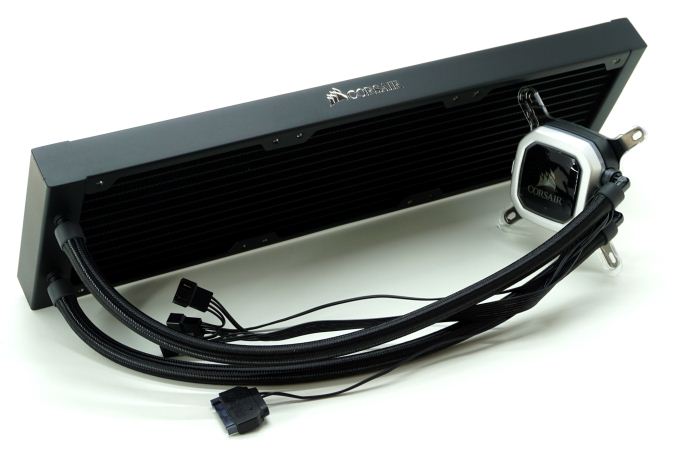
Corsair is one of the oldest companies in the PC market. The company became known for their memory-related products but, following the explosive growth of PCs at the dawn of the millennium, the company began diversifying into other segments of the market. Corsair was reluctant at first, releasing just a couple of new products each time. Most of their attempts were highly successful and driven the company to furiously expand over the last decade, creating the entrepreneurial giant that every computer enthusiast knows of today.
One of the company's most successful products segment today is their all-in-one (AIO) liquid coolers. That is somewhat ironic, considering that the liquid cooling market was one of the company's first diversification targets back in 2003 and their attempt was largely unsuccessful. That was because the product that they marketed back then in collaboration with Delphi, the HydroCool 200, was not successful due to its size, cost, and complexity. Corsair repeated their attempt to claim a piece of the cooling market share many years later after the company had already several other successful diversification attempts and the AIO designs were more mature.
Fast forward to today and the liquid-based AIO coolers are amongst Corsair's most popular products. We have reviewed several of their products in the past, ranging from cost-effective designs to advanced products with a software interface. In this review, we are taking a look at their recently released and largest AIO cooler, the H150i Pro RGB. The H150i Pro is largely based on previous popular AIO cooler designs but is using a massive 360 mm radiator and features programmable RGB lighting.
Packaging & Bundle
We received the H150i Pro RGB into a long rectangular box that clearly hints the size and shape of the cooler. The designer did not stick to the usual black-yellow theme that is Corsair's insignia, but instead added a full-color spectrum at the front of the packaging to signify the product's RGB lighting. Information regarding the features and technical specifications of the cooler are printed on the sides and rear of the box. Inside the box, we found the cooler and its parts well protected by a custom cardboard insert.
Corsair supplies all of their advanced Hydro coolers in similarly sized and designed cardboard boxes. Essentially, the only thing that changes is the picture of the product and the color theme. The design is simple but elegant and attractive, with enough information printed on the box and in several languages. Inside the box, the coolers are well protected into a custom cardboard insert.
The bundle of the H150i Pro is Spartan, especially considering the premium character of the product, with Corsair supplying only the absolute essentials. Inside the box, we only found the hardware necessary for the mounting of the cooler onto the CPU socket and an internal USB 2.0 header cable. It is also important to mention that Corsair's universal bracket supports most of Intel's and AMD's current processors, yet it is not compatible with the SP3r2/TR4 socket. Corsair mentions that the H150i Pro RGB now supports the SP3r2/TR4 socket via another mounting bracket that was not included into our packaging.
Corsair supplies three 120 mm fans for use with the H150i Pro RGB. The Corsair ML (MagLev) fans are rebranded and so we cannot tell who the OEM behind them is. Nevertheless, these are very high quality fans with magnetic levitation engines. Their plastic frame also is significantly reinforced. According to Corsair's specification sheet, these fans have a maximum rotational speed of 1600 RPM, a maximum static pressure (i.e. zero flow) of 1.78 mmH2O, and a maximum airflow (i.e. open air, no resistance) of 47.3 CFM. These numbers are hardly impressive for an advanced AIO cooler, clearly indicating that the H150i Pro RGB is designed for quiet operation and relies on its massive radiator to provide good thermal performance.


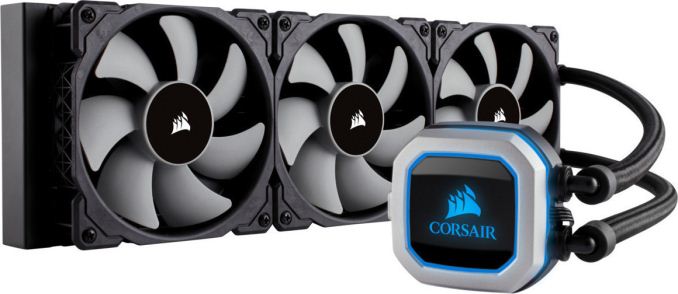
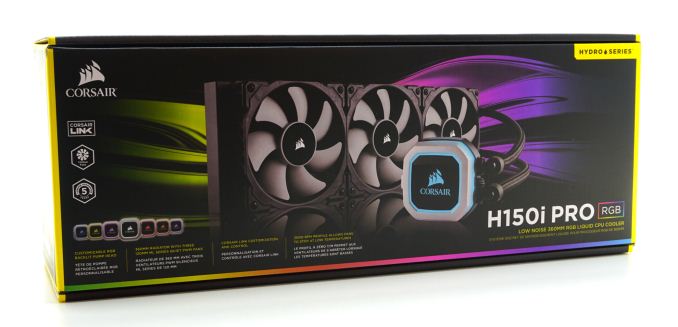
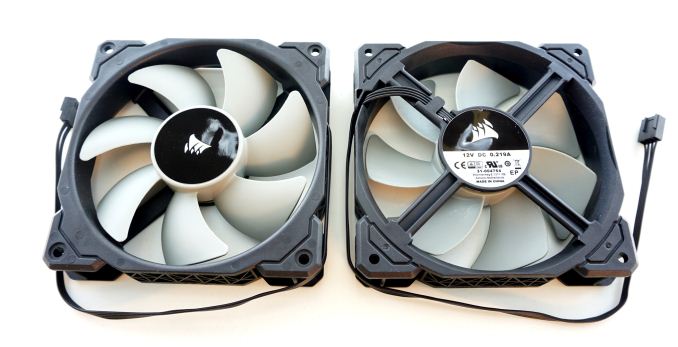
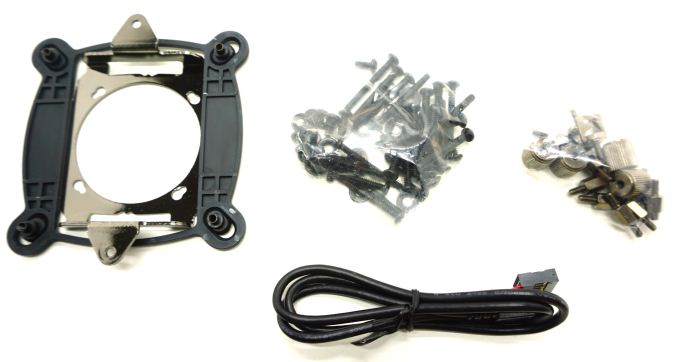








42 Comments
View All Comments
Wolfclaw - Friday, August 17, 2018 - link
I'll stick to my Arctic 240 with its 4 fans, £75 and keeps my R5-2600 cool and quiet !imaheadcase - Friday, August 17, 2018 - link
I'm actually surprised Intel and AMD just don't ship small water AIO with retail cpu by now. I guess they are still afraid of the old "it has water it can mess stuff up" mentality.Oxford Guy - Friday, August 17, 2018 - link
AMD did that with the 9590.Icehawk - Saturday, August 18, 2018 - link
I believe Intel also offered them at one point - not very good ones though.Orange_Swan - Tuesday, August 21, 2018 - link
to be fair with a 225w tdp it was probably cheaper than building a comparable air coolernpp - Friday, August 17, 2018 - link
"The noise floor of our recording equipment is 30.2-30.4 dB(A), which represents a medium-sized room without any active noise sources."This is false and misleading, as is the whole table stating among others that anything below 35dBa is "virtually inaudible".
Really sad that silentpcreview.com is gone now, as are the days when such dubious and downright erroneous statements wouldn't have made their way into an anandtech review.
Oxford Guy - Friday, August 17, 2018 - link
My favorite example is when the same review site that glosses over fan noise later gushes about the silence afforded by a fanless PC. Which is it? Either all those fans are "silent" and "inaudible" or they're not.Tell a tinnitus sufferer about silent PC fans. It is, for instance, very possible for a person to be able to tolerate many, much louder, sounds — like air conditioner fans and car trip noise, and yet get much worse tinnitus reaction problems from these supposedly silent/quiet/inaudible PC parts.
I've been waiting many years for a high-performance fanless case but it looks like the lastest one, the Calyos, is vaporware. Apparently, the designers have moved to a new startup to create more vaporware, albeit with worse specs.
Ryan Smith - Friday, August 17, 2018 - link
So the standard that is usually quoted for a quiet room in a rural area is 30 dB(A).http://www.dot.ca.gov/dist2/projects/sixer/loud.pd...
In practice you won't find that rooms can get much quieter than that without using sound-absorbing designs, be it a recording studio or anechoic chamber.
Now if you have findings that say otherwise, we're more than happy to look at them. After all, we strive for accuracy. But what I can say for certainty is that none of our testing environments get below 30 dB(A).
npp - Friday, August 17, 2018 - link
Ryan, this a review of the legendary Scythe Ninja done by SPCR in 2005, long before they built their hemi-anechoic chamber:https://bit.ly/2MA3g5E
As you can see, the ambient SPL was 18dBA (without room treatment) and the fan did rise up to about 22dBA, which according to the quoted data should be inaudible. Of course, if the noise floor in the room is 30dBa, one could go on and state that the cooler is silent, and this wouldn't be true.
I'm not trying to argue or split hairs here, but if you want to include SPL measurements, you should take them more seriously. A room with 30dBa noise floor isn't the best place to perform such measurements to begin with and makes judgement of the sound performance of various fans highly unreliable.
Now regarding what constitutes a quite room, this is really a subjective matter. The common consensus is around 20-30dBA, I personally would call 20dBa quite enough.
Diji1 - Friday, August 17, 2018 - link
>A room with 30dBa noise floor isn't the best place to perform such measurementsFair point but it's not as though most users are going to be using the product in super quiet spaces like that.